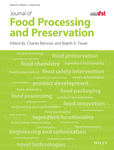Effectiveness of electron beam irradiation for microbial decontamination of turmeric powder (Curcuma longa Linne) and analysis of curcuminoid degradation
Funding information: The Seven Chemical Co., Ltd
Abstract
The effectiveness of electron beam (EB) disinfection and sterilization technology when applied to turmeric powder (Curcuma longa Linne) was investigated. The bacteria in turmeric powder were sensitive to EB irradiation. From an initial turmeric aerobic bacterial count of 107 colony-forming units per gram (cfu/g), a microbial contamination level of below 1.0 × 103 cfu/g was obtained at an absorbed dose of more than 7 kGy EB irradiation. EB irradiation at 10 kGy gave a contamination level of less than 10 cfu/g after 1 year of storage at room temperature. At the irradiation level necessary for decontamination of turmeric powder, the amount of dilute ethanol-soluble extract from the sample was 9% greater than the level from a non-irradiated turmeric powder. HPLC analysis of an irradiated sample indicated that EB radiolysis of curcuminoids was less than the level detectable by instrumental analysis.
Practical applications
Radiosterilization has been recognized as an effective method for controlling microorganisms and for extending the shelf life of food. In particular, EB irradiation is economically advantageous over gamma irradiation because of the higher EB dose rate. This study evaluates the use of 4.8 MeV EB radiation for the decontamination of turmeric powder for food additive and pharmaceutical uses. This method is found to be effective for sterilization and avoiding degradation of the yellow pigment components.




